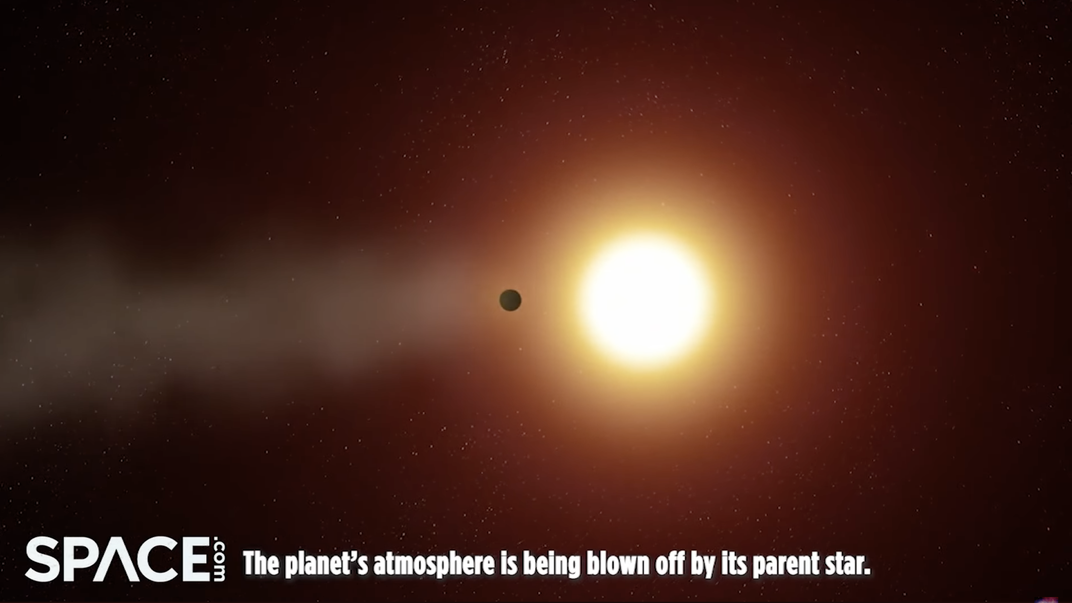This Distant Exoplanet Has a 350,000-Mile-Long Tail, Like a Comet
A stream of particles flung from the planet’s star is causing its atmosphere to boil away and lose 200,000 tons of mass per second
:focal(585x435:586x436)/https://tf-cmsv2-smithsonianmag-media.s3.amazonaws.com/filer_public/9b/63/9b635373-2c2b-4c20-9ca4-8f236a148240/hotplanettailmain.jpg)
A gas giant called WASP-69b in a distant solar system orbits its sun at a rapid pace—and it’s leaving a massive trail of its own atmosphere in its wake.
Stars eject fast-moving streams of particles called stellar wind, and this force from WASP-69b’s star is kicking gas out of the planet’s atmosphere, forming a tail that stretches at least 350,000 miles behind it, researchers report in a study published January 9 in the Astrophysical Journal.
Discovered in 2014, WASP-69b resides 163 light-years from Earth. It’s mostly made of gas, and while it’s slightly larger than Jupiter, it has less than a third of Jupiter’s mass.
WASP-69b is also in a very tight orbit, taking just under four days to circle its star from less than 5 percent of the distance between Earth and our sun. Such planets that are close to Jupiter in size but orbit very near to their stars are called “hot Jupiters,” per the New York Times’ Robin George Andrews.
“This is an extreme environment,” lead author Dakotah Tyler, an astrophysicist at the University of California, Los Angeles (UCLA), said at a press briefing last week during a meeting of the American Astronomical Society, per Business Insider’s Morgan McFall-Johnsen and Kelsey Vlamis.
Previously, scientists had observed a tail of gas extending behind WASP-69b that looked to be about 2.2 times the radius of the planet in length, according to the study. But they were unsure if the tail, which seemed to be made of helium gas, actually existed, writes Space.com’s Sharmila Kuthunur.
For the new paper, the researchers looked at the planet using the W. M. Keck Observatory in Hawaii. They observed a tail mostly made of hydrogen and helium stretching for hundreds of thousands of miles behind WASP-69b—about seven times the width of the exoplanet.
“Work by previous groups showed that this planet was losing some of its atmosphere and suggested a subtle tail or perhaps none at all,” Tyler says in a statement from UCLA. “However, we have now definitively detected this tail.”
The planet’s proximity to its star enables the stellar wind to expel WASP-69b’s atmosphere.
“Most hot Jupiters are losing mass in this way, but not all of them have tails,” Tyler tells the New York Times. “The only way to get the tail is if you have an excessive stellar wind that reshapes and sculpts it, basically like a comet.”
WASP-69b is hemorrhaging massive amounts of gas, losing 200,000 tons of mass every second. The researchers estimate the planet loses roughly an Earth’s-worth of mass every billion years. But since the planet is around 90 times as massive as Earth, it’ll hold on to most of its mass over the course of its lifetime.
It’s “quite a bit” of mass loss, Tyler said at last week’s press briefing, per Space.com. “But for a hot Jupiter, it’s really not that much.”
This deteriorating planet suggests an answer to a cosmic puzzle: Scientists have noticed that not many known exoplanets have radii between 1.4 and 2 times that of Earth’s. One reason why could be that stars quickly shrink these planets by evaporating their outer layers, writes Business Insider.
WASP-69b is not the first planet found to have such a comet-like tail. “We have found other planets with tails,” Jessie Christiansen, a NASA project scientist at the NASA Exoplanet Archive who did not contribute to the findings, tells the New York Times. Studying WASP-69b could help scientists better understand how stars boot gas from planets’ atmospheres.
“Over the last decade, we have learned that the majority of stars host a planet that orbits them closer than Mercury orbits our sun and that the erosion of their atmospheres plays a key role in explaining the types of planets we see today,” Erik Petigura, a co-author of the study and astrophysicist at UCLA, says in the university’s statement. “However, for most known exoplanets, we suspect that the period of atmospheric loss concluded long ago. The WASP-69b system is a gem, because we have a rare opportunity to study atmospheric mass-loss in real time and understand the critical physics that shape thousands of other planets.”
/https://tf-cmsv2-smithsonianmag-media.s3.amazonaws.com/accounts/headshot/Will-Sullivan-photo.png)


/https://tf-cmsv2-smithsonianmag-media.s3.amazonaws.com/accounts/headshot/Will-Sullivan-photo.png)